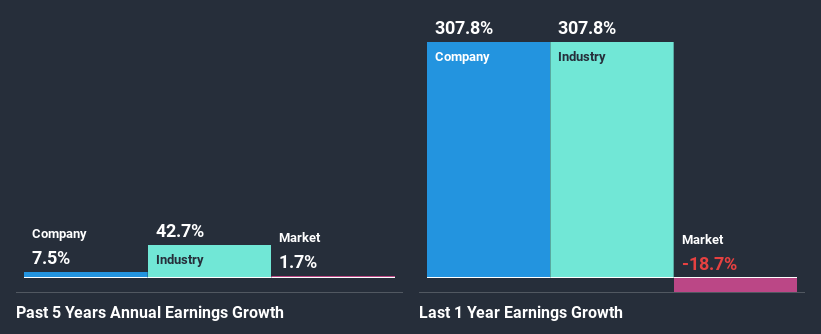- South Africa
- /
- Metals and Mining
- /
- JSE:THA
Do Its Financials Have Any Role To Play In Driving Tharisa plc's (JSE:THA) Stock Up Recently?
Tharisa's (JSE:THA) stock is up by a considerable 50% over the past three months. We wonder if and what role the company's financials play in that price change as a company's long-term fundamentals usually dictate market outcomes. In this article, we decided to focus on Tharisa's ROE.
Return on Equity or ROE is a test of how effectively a company is growing its value and managing investors’ money. In simpler terms, it measures the profitability of a company in relation to shareholder's equity.
See our latest analysis for Tharisa
How To Calculate Return On Equity?
Return on equity can be calculated by using the formula:
Return on Equity = Net Profit (from continuing operations) ÷ Shareholders' Equity
So, based on the above formula, the ROE for Tharisa is:
17% = US$55m ÷ US$321m (Based on the trailing twelve months to September 2020).
The 'return' is the income the business earned over the last year. Another way to think of that is that for every ZAR1 worth of equity, the company was able to earn ZAR0.17 in profit.
What Has ROE Got To Do With Earnings Growth?
So far, we've learned that ROE is a measure of a company's profitability. We now need to evaluate how much profit the company reinvests or "retains" for future growth which then gives us an idea about the growth potential of the company. Generally speaking, other things being equal, firms with a high return on equity and profit retention, have a higher growth rate than firms that don’t share these attributes.
Tharisa's Earnings Growth And 17% ROE
At first glance, Tharisa's ROE doesn't look very promising. However, its ROE is similar to the industry average of 21%, so we won't completely dismiss the company. Even so, Tharisa has shown a fairly decent growth in its net income which grew at a rate of 7.5%. Considering the moderately low ROE, it is quite possible that there might be some other aspects that are positively influencing the company's earnings growth. Such as - high earnings retention or an efficient management in place.
We then compared Tharisa's net income growth with the industry and found that the company's growth figure is lower than the average industry growth rate of 43% in the same period, which is a bit concerning.

Earnings growth is an important metric to consider when valuing a stock. It’s important for an investor to know whether the market has priced in the company's expected earnings growth (or decline). Doing so will help them establish if the stock's future looks promising or ominous. One good indicator of expected earnings growth is the P/E ratio which determines the price the market is willing to pay for a stock based on its earnings prospects. So, you may want to check if Tharisa is trading on a high P/E or a low P/E, relative to its industry.
Is Tharisa Using Its Retained Earnings Effectively?
Tharisa has a low three-year median payout ratio of 21%, meaning that the company retains the remaining 79% of its profits. This suggests that the management is reinvesting most of the profits to grow the business.
Additionally, Tharisa has paid dividends over a period of three years which means that the company is pretty serious about sharing its profits with shareholders. Based on the latest analysts' estimates, we found that the company's future payout ratio over the next three years is expected to hold steady at 20%. As a result, Tharisa's ROE is not expected to change by much either, which we inferred from the analyst estimate of 15% for future ROE.
Conclusion
On the whole, we do feel that Tharisa has some positive attributes. Specifically, its fairly high earnings growth number, which no doubt was backed by the company's high earnings retention. Still, the low ROE means that all that reinvestment is not reaping a lot of benefit to the investors. That being so, a study of the latest analyst forecasts show that the company is expected to see a slowdown in its future earnings growth. To know more about the latest analysts predictions for the company, check out this visualization of analyst forecasts for the company.
If you decide to trade Tharisa, use the lowest-cost* platform that is rated #1 Overall by Barron’s, Interactive Brokers. Trade stocks, options, futures, forex, bonds and funds on 135 markets, all from a single integrated account. Promoted
Valuation is complex, but we're here to simplify it.
Discover if Tharisa might be undervalued or overvalued with our detailed analysis, featuring fair value estimates, potential risks, dividends, insider trades, and its financial condition.
Access Free AnalysisThis article by Simply Wall St is general in nature. It does not constitute a recommendation to buy or sell any stock, and does not take account of your objectives, or your financial situation. We aim to bring you long-term focused analysis driven by fundamental data. Note that our analysis may not factor in the latest price-sensitive company announcements or qualitative material. Simply Wall St has no position in any stocks mentioned.
*Interactive Brokers Rated Lowest Cost Broker by StockBrokers.com Annual Online Review 2020
Have feedback on this article? Concerned about the content? Get in touch with us directly. Alternatively, email editorial-team (at) simplywallst.com.
About JSE:THA
Tharisa
An investment holding company, engages in the mining, processing beneficiation, marketing, sale, and logistics of platinum group metals (PGMs) and chrome concentrates in South Africa, China, Singapore, Hong Kong, the United Arab Emirates, an internationally.
Flawless balance sheet with reasonable growth potential.
Market Insights
Community Narratives



